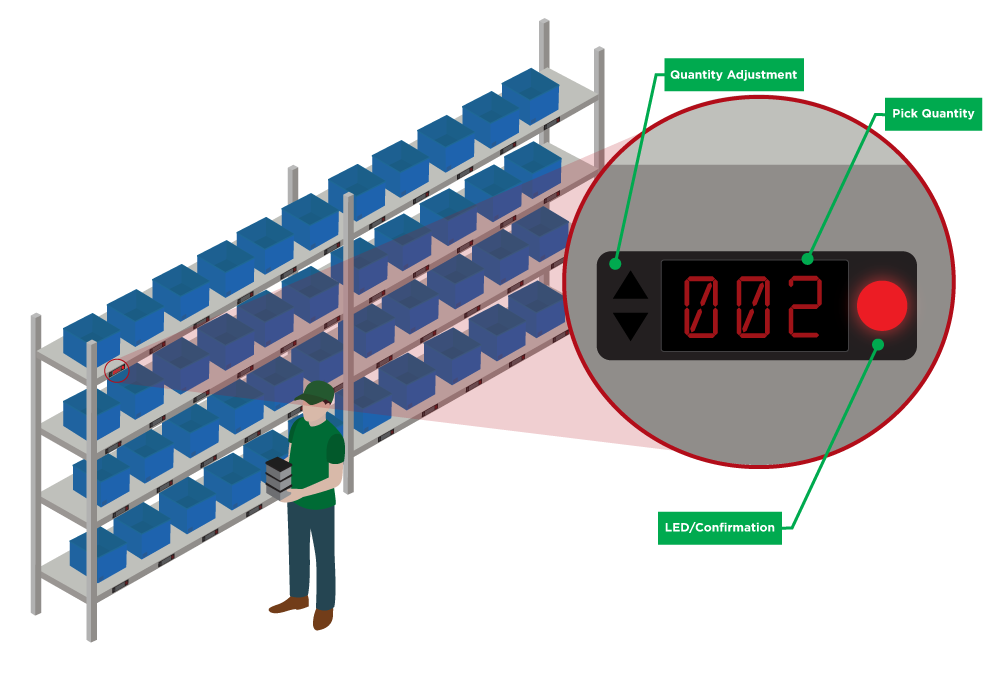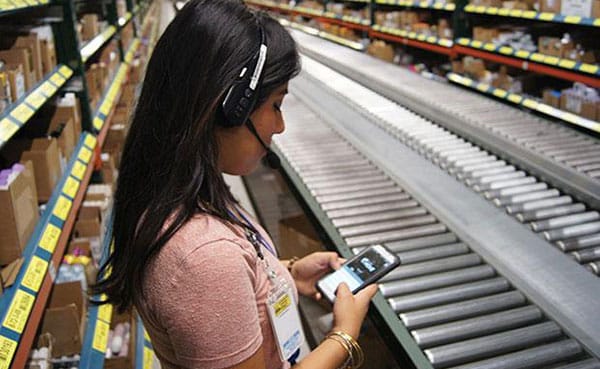Pick to light (or PTL) is an order picking technology for warehouses and distribution centers that utilizes lights and LEDs on racks or shelves to indicate pick locations and guide order pickers through their work. Pick to light systems increase picking efficiency compared to so-called RF picking or paper pick lists. Although PTL can been used for picking cases or eaches, it is most often used today for picking less-than-case quantities in high density/high velocity pick modules.
This article provides an overview of the pros and cons of PTL and compares it to voice picking, another popular technology for improving picking productivity in the DC.
What Are The Components Of A Pick To Light System?
Pick to light systems have been around since the 1990s, and the technology has evolved significantly since then. The principal components of a light-directed picking system today are:
- Lighting terminals placed on every pick location.
- Traditional-Wired lighting terminals (for power and communications with controllers) can include multiple lights and an alphanumeric LED screen to indicate quantities required to be picked.
- Modern-Wireless terminals connect via WiFi rather than network cabling, but still require wiring for power, although some pick to light providers offer wireless light terminals that are battery powered.
- Barcode scanner to “induct” or identify totes or cartons corresponding to a particular order.
- Pick to Light software to control the lights and communicate with a WMS or other systems.
How Does a Pick to Light System Work?
The typical pick to light process follows these basic steps
- The associate will begin their work by scanning a barcode that is on a tote or carton – this identifies the order for the pick to light software.
- The system will light up the terminals at the required pick locations for the order, creating a path to guide the associate. The LED screen at each lighted pick location will also indicate the pick quantity.
- The associate will pick the item and confirm the pick by pressing a button. In the event of a short pick (insufficient product), most systems allow the associate to adjust the quantity using up and down buttons on the light terminals.
- The associate will continue picking until the pick to light unit [“002” on image below] displays “END” or no further lights illuminate, indicating the order is complete in the employees pick zone.

What Are The Pros and Cons of Pick to Light Systems?
PTL users gain speed, accuracy and efficiency compared to paper-based picking processes. PTL is usually more efficient and productive than RF-based picking, but RF picking is still typically more accurate. Other advantages include:
- Easy to use and train– Training associates in a paper or RF-based picking system may take several hours or days. With a PTL system, associates will not need a detailed knowledge of the warehouse and product slots. Therefore, training is reduced significantly.
- Improved productivity– Light systems reduce the time per pick by eliminating the need to read pick instructions on paper or RF screen, and also save time scanning the pick face for the correct location.
- Added visibility– Light directed solutions can provide WMS or other host systems with additional visibility and data into picking rates compared to paper based picking.
On the other hand, pick to light systems have some disadvantages:
- Throughput and scalability – Most light-directed systems can have only one person in a work zone at a time, which reduces potential throughput. In addition, since the lights are wired to the shelving location, it can be expensive and time consuming to expand or modify a pick to light system.
- Item count accuracy – Because pickers simply press a light to confirm their pick, they are not required to positively acknowledge or confirm the number of items they are picking. In addition, for items that can be picked in different pack factors – box of three and/or eaches – there is a higher probability of unit count errors.
- Item verification – Pickers have no way to know if the correct item is in the pick location.
- Lack of flexibility – Lights aren’t easily reconfigured for operations that continuously reslot their warehouse or DC.
- Exception handling – Light systems don’t provide any way for users to communicate other exception conditions (damaged goods, for example); or to receive special instructions (packaging, other warnings or help)
- Limited applicability – Although PTL can be used for a variety of picking processes, it is typically only cost effective in higher-volume piece picking applications.
Comparing Voice and Light-Directed Work Execution Solutions
Pick to light solutions are intended primarily to address the productivity shortcomings of scanning and paper-based systems. Next-generation voice-directed systems can typically match or exceed the productivity rates of light-directed systems, while improving accuracy (especially item counts), among other advantages.
- Versatility: PTL is best suited for processes where products are small and pick-faces are dense, but they are less cost-effective in other applications. Voice picking systems can support multiple picking styles and virtually any other warehouse task, which improves labor flexibility and accelerates cross-training
- Speed and accuracy: Light systems place an emphasis on speed but accuracy may suffer in comparison to voice- or scan-based solutions where additional checks are built in. Light systems offer no means to verify the products in a pick location, or to communicate to users pack factors or other heads-up messages.
- Real-time data capture: Manual data entry may be required to capture exceptions (damage, wrong item in slot, etc.) that cannot be reported immediately in the pick-to-light process.
- Comprehensive labor reporting: Pick to light systems provide simple productivity reporting based on user interactions with the lights. RF and voice systems each provide richer activity data for workforce and labor management purposes.
- Cost: PTL systems typically require a large initial capital investment and high long-term maintenance costs. Adding new locations requires you to add more equipment, unlike voice where the system is not tied to the physical locations.
Compared to pick to light, voice-directed picking systems provide greater flexibility, versatility, and accuracy without sacrificing productivity, in addition to lower investments and ownership costs.
Implement Voice-Directed Picking in Your Warehouse
Since 1998, we’ve helped over 500 warehouses and DCs dramatically increase worker productivity, operational agility and accuracy with our intelligent voice applications, featuring Jennifer™.
We’d love to do the same for you and get you started, you can schedule a call with one of our voice experts here.






